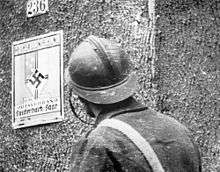Saar Offensive
| Saar Offensive | |||||||
|---|---|---|---|---|---|---|---|
| Part of the Phoney War of World War II | |||||||
 Map showing the disposition of French forces and territory occupied during the offensive | |||||||
| |||||||
| Belligerents | |||||||
|
|
| ||||||
| Commanders and leaders | |||||||
|
|
| ||||||
| Strength | |||||||
|
40 Divisions 2,400 tanks 4,700 artillery |
22 Divisions less than 100 artillery | ||||||
| Casualties and losses | |||||||
| 2,000 killed, wounded and sick[1] |
196 dead 114 missing 356 wounded[2] 11 aircraft[3] | ||||||
The Saar Offensive was a French ground operation into Saarland, Germany, during the early stages of World War II, from 7 to 16 September 1939. The plans called for roughly 40 divisions, including one armored division, three mechanised divisions, 78 artillery regiments and 40 tank battalions to assist Poland, which was then under invasion, by attacking Germany's understrength western front. Although 30 divisions advanced to the border (and in some cases across it), the assault never happened. When the quick victory in Poland allowed Germany to reinforce their lines with homecoming troops, the offensive was stopped. The French forces eventually withdrew amid a German counter-offensive on 17 October.
Objective of the offensive
According to the Franco-Polish military convention, the French Army was to start preparations for the major offensive three days after Mobilisation started. The French forces were to effectively gain control over the area between the French border and the Siegfried Line and were to probe the German defenses. The sector was defended by the German 1st Army. On the 15th day of the mobilization (that is on 16 September), the French Army was to start a full-scale assault on Germany. The pre-emptive mobilization was started in France on 26 August and on 1 September, full mobilization was declared.
French mobilization suffered from an inherently out of date system, which greatly affected their ability to swiftly deploy their forces on the field.[4] The French command still believed in the tactics of World War I, which relied heavily on stationary artillery, even though this took time to transport and deploy (many pieces also had to be retrieved from storage before any advance could be made).[5]
French operations

A French offensive in the Rhine valley began on 7 September, four days after France declared war on Germany. The Wehrmacht was engaged in the attack on Poland and the French enjoyed a decisive numerical advantage along the border with Germany but the French did not take any action that was able to assist the Poles. Eleven French divisions, part of the Second Army Group, advanced along a 32 km (20 mi) line near Saarbrücken, against weak German opposition. The French army advanced to a depth of 8 km (5.0 mi) and captured about twelve villages and towns unopposed.[lower-alpha 1] Four Renault R35 tanks were destroyed by mines north of Bliesbrück. On 10 September there was a small German counter-attack on the village of Apach, which was retaken by French forces some hours later. On 12 September, the 32nd Infantry Regiment seized the German town of Brenschelbach with the loss of one captain, one sergeant and seven privates.[1] At the French-German-Luxembourgeois border, the Schengen bridge was destroyed.[6] The half-hearted offensive was halted after France occupied the Warndt Forest, 3 sq mi (7.8 km2) of extensively-mined German territory. The French army failed to reach the Siegfried line.
Aftermath

The attack did not result in any diversion of German troops. The 40-division all-out assault never materialised. On 12 September, the Anglo French Supreme War Council gathered for the first time at Abbeville in France. It was decided that all offensive actions were to be halted immediately. General Maurice Gamelin ordered his troops to stop "not closer than 1 kilometre" from the German positions along the Siegfried Line. Poland was not notified of this decision. Instead, Gamelin informed Marshal Edward Rydz-Śmigły that half of his divisions were in contact with the enemy, and that French advances had forced the Wehrmacht to withdraw at least six divisions from Poland.
The following day, the commander of the French Military Mission to Poland, General Louis Faury, informed the Polish chief of staff, General Wacław Stachiewicz, that the planned major offensive on the western front had to be postponed from 17 to 20 September.
From 16 to 17 October, the German army, now reinforced with troops returning from the Polish campaign, conducted a counteroffensive that retook the remainder of the lost territory, still held by French covering forces, which withdrew, as planned.[7][8] German reports acknowledge the loss of 196 soldiers, plus 114 missing and 356 wounded.[2] They also claim that 11 of their aircraft had been shot down as far as 17 October.[3] The French suffered around 2,000 casualties.[1] By then, all French divisions had been ordered to retreat to their barracks along the Maginot Line. The Phoney War had begun.
Notes
- ↑ Gersheim, Medelsheim, Ihn, Niedergailbach, Bliesmengen, Ludweiler, Brenschelbach, Lauterbach, Niedaltdorf, Kleinblittersdorf, Auersmacher and Hitlersdorf (now Sitterswald).
Footnotes
- 1 2 3 Fmod 2015.
- 1 2 "Berlin Diary" by William Shirer, 20 October 1939
- 1 2 "Berlin expects Italy will react to New Turkish Treaty" Associated Press, 20 October 1939
- ↑ Snyder 1960, pp. 95–96.
- ↑ Liddell Hart 1970, pp. 31–33.
- ↑ Government of Luxembourg. The Luxembourg Grey Book, Hutchinson & Co. Accessed 13 March 2016
- ↑ Kaufmann & Kaufmann 2002, p. 97.
- ↑ Germans counterattack in the Saar region Monday, October 16, 1939. Chronology of WWII
References
- Liddell Hart, B. H. (1970). History of the Second World War. New York: Putnam. OCLC 878163245.
- Kuffmann, J. E.; Kaufmann, H. W. (2002). Hitler's Blitzkrieg Campaigns: The Invasion And Defense Of Western Europe, 1939–1940. Boston, MA: Da Capo Press. ISBN 0306812169.
- "La drôle de guerre". Paris: Ministére de la Defénse. Retrieved 27 October 2015.
- Snyder, Louis L. (1960). The War: A Concise History 1939–1945. New York: Julian Messner. OCLC 964796.